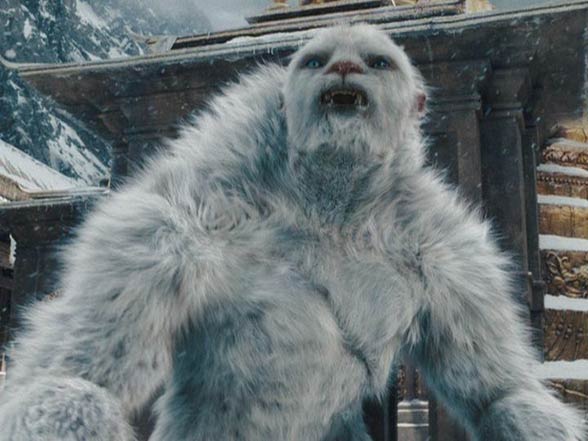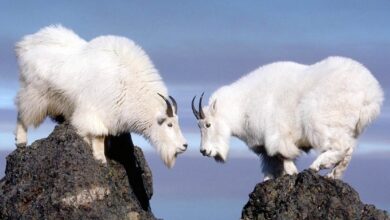Yeti – does it exist?
The hero of many films, fairy tales and computer games. It stimulates the imagination of conspiracy theorists, but it also raises concerns in the hardened minds of skeptics. The Abominable Snowman, also known as Yeti, is an example of how an inquisitive scientific world does not want or cannot find answers to the mysteries of nature that we have been hearing about for at least 100 years. However, we will try to tell you something about a mysterious inhabitant of the Himalayas and, regardless of the reader’s views, show that things are happening in the world that are sometimes hard to deny.
Basic information
- Status: cryptid – an animal whose existence was only suggested because there is no scientific evidence for it
Where does Yeti live?
- Potential locations: the Himalayan region, mainly Tibet, Bhutan, India and Nepal, as well as China, Mongolia and Russia
Names
- Other names: Man of Snow, Abominable Snowman, Migoi, Mi-go, Meh-teh et al, Kang Admi, Mirka, Bun Manchi, Dzu-teh, Michê

Reports
The first information about Yeti in the West appeared in the 19th century, thanks to the accounts of Brian Houghton Hodgson, a British naturalist who researches the nature of India and Nepal. According to the description, the local Hodgson’s guide met a tall, two-legged creature in northern Nepal, covered with long, dark hair. When she noticed a man, she escaped fearfully. After this event, Hodgson said that his guide was dealing with an orangutan.
The first traces of unknown creatures found in these areas were observed by Laurence Waddell in 1899. In his accounts, he wrote that he met a large monkey-like creature, leaving large traces of its feet on the ground. After looking at these traces, Waddell found that they could be bear traces. Although the military had heard many stories from the Tibetans about a large monkey-like man, he did not believe that information.

However, a large creature from the Himalayas, resembling a monkey, was mentioned earlier. According to H. Siiger, Yeti was a part of Buddhist beliefs among the inhabitants of the region, mainly the Lepcha people. In the ancient Tibetan religious tradition called Bön, the blood of the so-called “wild man” was to be used in some mystical ceremonies. As you can see, the figure of “man of snow” did not come into being in our times, but much earlier.
In the times closer to us, reports about an extraordinary creature from the Himalayas did not disappear. A lot of books have been written about it, including Still Living?, Yeti, Sasquatch, and the Neanderthal Enigma, by Myra Shackley, a researcher who reported two 1942 travelers in this book, noticed two black dots on the snow, moving about 400 meters below them. Despite the long distance, the travelers created a very detailed description of what they had observed.
According to their information, the first character was about 2 m tall, both heads were big, the ears were very close to the skull. The arms were strongly inclined forward, and the body of the first individual was covered with rusty brown hair, forming thick fur. The second creature had the size and structure of a small man, his head was covered with long hair, while his face and chest remained naked. The first creature moved on two legs and was busy digging out the roots, from time to time making a loud, squeaky scream.

True or false?
Are these relationships true? Unfortunately, we will not know that anymore. However, to suggest the words of the famous mountaineer Reinhold Messner, who spent months in Nepal and Tibet, large bears and their footprints are often attributed to Yeti. This does not change the fact, however, that over the course of many decades travelers fascinated by the Himalayas met on their way mysterious creatures that move bipedal and resembling powerful monkeys. This is evidenced by numerous photographs, e.g. those taken in 1986 by Anthony Wooldridge.
The authenticity of such photographs was decided many times by John Napier, an anthropologist and anatomist, who was the director of the Smithson Institute for the biology of primates. However, many of these photographs, including those taken by Wooldridge, today are considered to be an optical illusion, e.g. a cluster of dark stones resembling a double-legged figure from a distance.

Evidence?
If the scientists obtained clear evidence for the existence of the Yeti, this creature would not be classified as a cryptid. Over the years, however, a large amount of material has been collected to suggest that Yeti reigns in the merciless mountains of Asia.
In the 1960s, Sir Edmund Hillary, the first man on Mount Everest, sought evidence of Yeti in the Himalayas. During his journey, he found the scalp of the beast, but scientists later found out that the helmet-shaped creature belonged to the serow, a medium-sized mammal similar to a goat.
In 2007, John Gates claimed to have found three traces of snow in the Himalayas near a stream. The locals were skeptical about these revolutions, because they believed that Gates confused these trails with traces of a bear.
For many years, it was believed that there was a Yeti finger in the Nepalese monastery. It was discovered in the 1950s, but in 2011 scientists found it to be a human finger, perhaps belonging to a monk.

Russians on the Yeti tracks
Recently, the Russian government took such an interest in Yeti that it decided to hold a conference of experts and send them to the west of Siberia. The expedition took place in October 2011 and was attended by, among others, the Big Foot seeker and biologist John Bindernagel. After returning from his research, he stated that he had found evidence not only of Yeti’s existence, but also of the fact that they formed nests of branches. The team of experts appeared on the covers of many magazines all over the world, when their members declared that they had gained undeniable proof of Yeti’s existence.
Based on their observations and research, they concluded that their confidence in this matter is 95%. The evidence of Yeti’s existence was supposed to be the remains of moss in caves and found grey hair. However, it was not necessary to wait long for the opposition of other scientists taking part in the expedition. One of them explicitly stated that potential evidence of Yeti’s existence is mystification.
Even Jeff Meldrum, a professor of anatomy and anthropology at the University of Idaho, who de facto supported the existence of the Big Foot, suspected that the intertwined branches of trees that were supposedly the nest of the Yeti were a forgery. Meldrum even risked saying that the entire Russian expedition was just a marketing trick aimed at increasing tourist traffic in the impoverished mining region.
For the supporters of Yeti’s theory of existence, his elusiveness for decades has simply been proof of his rarity and / or loneliness.

Theories on the origin of Yeti
The most frequently used argument by opponents of the theory of the existence of Yeti is a misinterpretation of photographs and ignorance of Himalayan fauna and flora. Yeti can be confused with animals such as Himalayan brown bear (Ursus arctos isabellinus), Tibetan blue bear (Ursus arctos pruinosus) or monkeys (Colobinae). Some skeptics, however, do not rule out the possibility that the alleged Yeti is a wandering hermit.
It was loud to find the hair in Bhutan that had been collected during one of the expeditions. DNA analysis was performed by Bryan Sykes, who discovered that hair samples, belonged to the brown bear and Asian black bear (Ursus thibetanus).
The account of the mountaineer Reinhold Messner, who claimed to have met Yeti face to face, was shocking. He described it in his book My Quest for the Yeti, adding that he killed one of them. However, he later stated that Yeti is the Himalayan brown bear or a Tibetan blue bear that can move on both its four and two limbs.

The 1980s
In the 1980s, research was carried out into unusual traces resembling traces of a large human being. Researchers Taylor, Fleming, Craighead and Shrestha have shown that these traces belong to young Himalayan bears, who spend most of their time on trees until they are about 2 years old, in order to avoid attacks from older and larger animals. The way the feet were arranged during climbing attempts on the tree could create a human footprint.
These discoveries led directly to the creation of the Makalu-Barun National Park in Nepal. The park was to protect over 500,000 ha of forests. In 1991, the Qomolangma National Park was established in Tibet to protect more than 2,400,000 hectares of land. Robert H. Bates, honorary president of the American Alpine Club, said that the mystery of Yeti, or at least a part of it, had apparently been discovered. He stated that Yeti leaves these traces on the ground, which would indicate that he lives on trees and not on high peaks of mountains.
Some people speculate that these creatures may be surviving representatives of a Gigantopithecus – a monkey that died out around 100 000 years ago. Yeti, however, is usually described as a two-legged animal, while the Gigantopithecus, due to its weight and height, probably moved on four limbs. To be honest, the Yeti at the Gigantopithecus is … a little Miki 🙂
In 2013, a number of analyses of hair samples from unidentified animals from northern India, more specifically from Ladakh, were carried out. The samples were compared with the polar bear gene sequence. The results of these comparisons were not clear, possibly due to contamination of the sample. Professor Brian Sykes, who conducted the analysis at Oxford University, has his own theory on this subject. He believes that a sample of not fully identified hair can come from a hybrid of two bear species: brown and polar.

The descendants of Yeti live in the Caucasus…
British geneticist Bryan Sykes analyzed the DNA of Abkhazian family. This family claims that it comes from a “Wild Woman” named Zana. Research carried out by Sykes shows that these people come from a group of hominids that came from Africa. Zana lived in the second half of the 19th century in the village of Tchina and was afraid of the local population… although she was tame. On the subject of where her descendants came from, we will not write much more 😉
Yeti – potential dimensions
- Height: 180-210 cm (found in North America, the Big Foot, also known as Sasquatch, is reported to be 2-3.5 m high)
- Weight: 90-180 kg (Big Foot weighs approx. 220 kg)
Yeti – curiosities
- In 2003, a Japanese researcher and mountaineer Dr. Makoto Nebuka published the results of his twelve-year research into the word “yeti”. He considered that the word originated from the “meti” word, which in the Tibetan dialect means ‘bear’. According to him, the Tibetans are afraid of bears and love them as supernatural beings. The results of his long research were almost immediately flooded with a wave of criticism, and the scientist himself was accused of linguistic negligence.
- A Yeti-like individual called the Big Foot is found in North America. It was told by indigenous inhabitants of the North-Western Pacific Coast.
- Other names for the Snow Man include: Michê (“Man – Bear”), Mirka, Migoi or Mi-go (“Wild Man”), Bun Manchi (“Jungle Man”), Kang Admi (“Snow Man”).



















